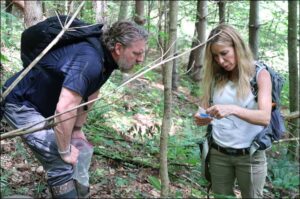AN ELITE TEAM OF RESEARCHERS RETURN FROM A TWO-MONTH CROSS-COUNTRY HUNT
WITH MYSTERIOUS EVIDENCE OF NON-HUMAN PRIMATE PRESENCE IN THE APPALACHIANS

The EXPEDITION BIGFOOT team collected surprising DNA evidence while in the field searching for the most famous and elusive cryptid, Bigfoot. Throughout their two-month journey, the team – Bryce Johnson (expedition operations), Dr. Mireya Mayor (primatologist), Russell Acord (ex-military/survivalist) and Ronny LeBlanc (Bigfoot researcher) – used the latest in advanced technologies to narrow their search within the designated target zones, beginning in Kentucky and then switching mid-expedition to Washington State. As the investigation intensified, possible evidence that Bigfoot may be in the area began to surface – vocalizations, unexplained structures commonly described by Bigfoot witnesses and massive 16-inch footprints that no man could have left behind.
During filming deep in the wilderness of Kentucky’s Appalachian highlands, eDNA collected from soil under a massive tree structure found by Dr. Mayor and LeBlanc produced surprising and exciting results. Environmental DNA (eDNA) is the genetic material naturally left behind by animals in the environment. Scientific analysis of these samples helps generate a snapshot of any living creatures. This revolutionary new tool is increasingly used to confirm the presence of elusive animals.
“This scientific expedition may have finally taken one of the world’s greatest mysteries out of the pages of legend and lore and into reality,” said Dr. Mayor.
Miroslava Munguia Ramos, project manager at the UCLA California Environmental DNA program, has analyzed the eDNA sample from the tree structure. Following are her observations.
- “We received soil samples from your team and took a few months to get them processed. What we’re looking at are the unique organisms that we were able to identify. Our software does what’s known as metabar coding. So, it’ll match up all the DNA sequences that we were able to detect and try to cross reference them with the thousands of genomes that have been published and it’s pretty common that when we’re looking at environmental DNA samples, we detect humans, because there’s going be human traces almost everywhere.”
- “But what I found very interesting was that, yes, we have detected human DNA in these areas, but we’re still seeing different primate DNA. There wasn’t just one human primate, there are several different primates, some sort of primate relative that exists in the data.”
- “Pan troglodyte is a species of chimpanzee, which you would not see in the areas you’re at. It’s a real head scratcher. It’s important to note that the higher the detection, the more confidence we can say that whatever organism, whatever taxonomy we’re looking at was apparent in the area. And in this case, we’re looking at the Pan genus, or the chimpanzee genus…. there’s 3000 reads.”
- “The technology is constantly improving, it’s getting more accurate, and now it just really comes down to making sure we have enough samples and we’re confident that whatever we’re studying is a unique species.”
Dr. Mayor expanded on this unique discovery.
- “Finding what appears to be a very large structure, seemingly created with intention and requiring great strength as well as foresight, is interesting. It is not unheard of for primates to stack sticks or rocks, although for me, the jury is still out as to what that was. There is no guess work in science. It is great is that eDNA was collected from that site. That may give us the answers we are looking for.”
- “The process of describing and confirming a new species is difficult. DNA is absolutely essential in the scientific community to prove that something is a new or recognized species. You have eyewitness accounts from tens of thousands of people who say they have encountered Bigfoot, some coming forward with blurry videos and photographs. But that is just not going to cut it. What we need is indisputable genetic evidence to really put this mystery to rest. And there’s no doubt in my mind that we are headed in the right direction.”
What does this all mean? Did they find Bigfoot? “Expedition Bigfoot” is currently streaming on discovery+. The series finale, “New Discoveries,” featuring the newly found eDNA evidence premieres on Sunday, March 28.
Follow @DiscoveryPlus and #ExpeditionBigfoot for exclusive content and the latest updates, and check discovery+ on , Facebook and Twitter.
ABOUT THE “EXPEDITION BIGFOOT” CAST
Bryce Johnson: Acclaimed actor/producer as well as creator and host of the popular podcast “Bigfoot Collectors Club,” Johnson has been obsessed with Bigfoot ever since he was a young boy. Although acting is his profession, researching the strange and unexplained, along with crypto-zoological creatures, are his passion. Those pursuits converged in 2013, when Johnson starred in the critically lauded movie “Willow Creek,” a found-footage horror film about a quest to find evidence of Bigfoot. While researching his role, Johnson met Robert “Bob” Gimlin, the man who, along with Roger Patterson, captured the legendary footage of Bigfoot in 1967. That meeting, and their subsequent friendship, cemented Johnson’s commitment to pursuing the truth about the existence of Bigfoot. He can be found on Twitter, Instagram and Facebook.
Dr. Mireya Mayor: World-renowned primatologist, Fulbright Scholar and National Science Foundation Fellow, Mayor is not your typical scientist. For nearly two decades, she has been a wildlife correspondent reporting on wildlife and habitat loss while advocating for solutions to the alarming trends. Mireya has been hailed as a “female Indiana Jones,” in the media and is an inspiration to young women interested in science and exploration. A two-time Emmy Award-nominated field correspondent for the National Geographic Channel, Mayor reports to audiences worldwide on pertinent wildlife and habitat issues. Her explorations have led to several scientific discoveries, most notably her co-discovery of the world’s smallest primates, a brand-new species to science. The daughter of Cuban immigrants, Mireya grew up in Miami and earned her bachelor’s degree in anthropology and English at the University of Miami and went on to earn her Ph.D. from Stony Brook University. She recently joined Florida International University as director of the Exploration and Science Communication Initiative. Mayor is also the author of “Pink Boots and a Machete: My Journey from NFL Cheerleader to National Geographic Explorer.” She can be found on Twitter, Instagram and Facebook, as well as on the Web.
Russell Acord: Author of “Footprints of a Legend” and “Bigfoot and the Tripwire,” event coordinator for the International Bigfoot Conference and skilled survivalist, retired Army Sergeant Russell Acord spends his free time traveling the Pacific Northwest looking for evidence of Bigfoot. Raised in the mountains of Montana, Accord takes a solid scientific approach to his Bigfoot research. His interest in the subject began when he saw the famous Patterson/Gimlin film, and he has been actively searching for Bigfoot since the late ‘70s. He can be found on Twitter, Instagram and Facebook, as well as the Web.
Ronny LeBlanc: Ronny LeBlanc is a globally recognized figure in the world of paranormal, Bigfoot and UFOs. LeBlanc is an independent researcher, screenwriter and author of the critically acclaimed and best-selling book “Monsterland: Encounters With UFOs, Bigfoot and Orange Orbs,” which details the history and connection between the various phenomena, highlighting his experience and a research area called Monsterland in central Massachusetts. Ronny was the first person ever to cast a Bigfoot print in the Bay State from a trackway discovered by a couple in Leominster State Forest in the summer of 2010. He is a regular speaker at the Exeter UFO Festival, New England UFO Conference and ParaFest and has been featured on nationally syndicated radio programs like “Coast to Coast AM with George Noory” and “Fade to Black with Jimmy Church.” He was recently highlighted for his research experience in a cover story for The Boston Herald. He is the founder and host of the “Monsterland” podcast. He can befound on Twitter, Instagram and Facebook, as well as the Web.




